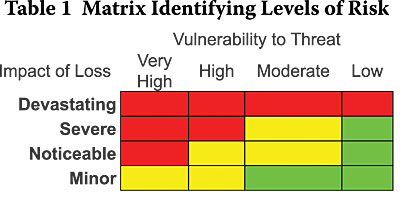Assessing Workplace Violence Risk to the Business

Over the last two decades, the Department of Labor and National Institute for Occupational Safety and Health (NIOSH) have provided insightful information on workplace violence fatalities and nonfatal incidents. While these statistical reports have provided essential details, in most cases businesses have not been able to translate them into cogent plans to address this ever-present problem. This article will focus on helping those charged with the responsibility for addressing workplace violence to understand the potential business and financial impact of violence on their work environment.
ASSESSING YOUR RISK
- Violence perpetrated by a stranger (generally robbery is the goal);
- Violence perpetrated by a current or former employee;
- Violence perpetrated by a relative, spouse, ex-spouse or individual with a personal relationship with an employee; and
- Violence perpetrated by a customer, client or contractor.
All organizations have exposure to all four types of violence, although to varying degrees. For example, if you are a retail business that handles lots of cash, the nature of the threat posed and type of potential violence you face will differ from the threat that hangs over a manufacturing plant. Likewise the threat posed to a warehouse located in a high crime area will be different from that posed to an office building in a busy downtown area. Each type of workplace violence requires a different type of assessment.
Numerous variables will impact these assessments, including the type of business, the type of facilities you operate, the level and nature of security at those facilities, hours of operation, level of staffing, presence of valuables or cash, and location.

ASSESSING YOUR VULNERABILITY
- Devastating: The facility is damaged/contaminated beyond habitable use. Most items/physical assets are lost, destroyed, or damaged beyond repair/restoration. Multiple deaths have occurred. The number of visitors to other facilities in the organization may be reduced by up to 75 percent for a limited period of time. An example of a devastating event would be the attack on the World Trade Center.
- Severe: The facility is partially damaged/contaminated. Examples include partial structure breach as a result of weather/water, smoke, fire, or impact damage to some areas. Some items/physical assets in the facility are damaged beyond repair, but the facility remains mostly intact. The entire facility may be closed for a period of up to two weeks and a portion of the facility may be closed for an extended period of time (more than one month). Some assets may need to be moved to remote locations to protect them from environmental damage. One or more deaths occur or a serious number of nonfatal injuries (these are injuries that would meet the OSHA reportable event standard). The number of visitors to the facility and others in the organization may be reduced by up to 50 percent for a limited period of time. Examples would include the recent attack in Mumbai or the killings at Virginia Tech. An example of a different type, but nevertheless that had similar impact, was the systems engineer that held the City of San Francisco hostage with protected passwords, denying city officials access to their computer systems.
- Noticeable: The facility is temporarily closed or unable to operate, but can continue without an interruption of more than one day. Note that the decision to close the facility is based on employee, community, and public relations and/or political factors rather than the facility being unavailable. A limited number of assets may be damaged, but the majority of the facility is not affected. Some injuries may occur, but not a significant number of them are serious enough to warrant reporting to OSHA. The number of visitors to the facility and others in the organization may be reduced by up to 25 percent for a limited period of time. An example would the robbery of a jewelry store in which several jewelry cases are severely damaged, but can be replaced. Employees will likely be highly stressed, afraid and apprehensive; however, the physical facility is capable of opening for business.
- Minor: The facility experiences no significant impact on operations (downtime is less than four hours) and there is no loss of major assets. There are no reportable injuries. Examples would include a credible bomb threat, a fight between employees that causes disruption in a single department, or a big scene caused by an intimate partner, who requires police to be called, but no injuries.
- Very High: location of facility is in a high crime area or rural area with a known long police response time; the level of deterrence and/or defense provided by the existing mitigation measures is inadequate (e.g., little or no security, no workplace violence prevention program or measures in place).
- High: location of facility is in a rural area that has a known long police response time and/or the level of deterrence and/or defense provided by the existing mitigation measures is inadequate.
- Moderate: location of facility is a moderate distance from law enforcement and expects moderate response time and/or the level of deterrence and/or defense provided by the existing mitigation measures is marginally adequate.
- Low: location is in close proximity to law enforcement with immediate response time and/or the level of deterrence and/or defense provided by the existing mitigation measures is adequate.
In addition, the type of workplace violence incident has to be considered when attempting to identify the appropriate vulnerability rating. For example, a workplace robbery is driven by the “attractiveness” of acquiring cash or other valuables (like jewelry, precious metals, etc.) whereas a terminated employee, intimate partner or disgruntled client is driven by the desire to get to the “target” of their rage, sense of injustice or other psychological factors. For the robber the higher the level of deterrence (or security and mitigation factors) in place the more the attractiveness of the facility diminishes because their goal is to escape with the valuables.
ASSESSING THE IMPACT
WHAT ACTION IS REQUIRED?
- The Bureau of Labor Statistics reported that during the 1990s, on average, 19 people were murdered at work each week or close to 1,000 people on an annual basis.
- Likewise they reported that so far in this Century workplace homicides have averaged 603 annually; a 13 percent increase in incidents occurred from 2006 to 2007.
- NIOSH reports the estimated cost for a workplace homicide is $850,000 per incident.
Due to the low statistical risk of the occurrence of workplace homicide a critical issue that is frequently overlooked when assessing the risk of workplace violence is the impact of an incident if it does occur.
RISK CAN BE MANAGED
Additionally, you should also be aware that workplace homicides are only the tip of the iceberg: A much larger risk is non-fatal workplace violence incidents. Between 1.5 and 2 million incidents are reported annually and many suspect this is underreported by more than 50 percent. These numbers include simple and aggravated assaults, robberies, thefts, rapes, and sexual assaults. These often less-than-sensational incidents may never be reported in the media, but they present a high financial risk to your organization. (Assume each non-fatal incident has a total cost of $2,500 and you have 10 of them: this is a $25,000 impact on your bottom line.)
Once you complete this assessment you will be ready to develop a framework for identifying the potential cost to your business of an actual incident and juxtapose this against the cost of implementing a model prevention plan.
Looking for a reprint of this article?
From high-res PDFs to custom plaques, order your copy today!






